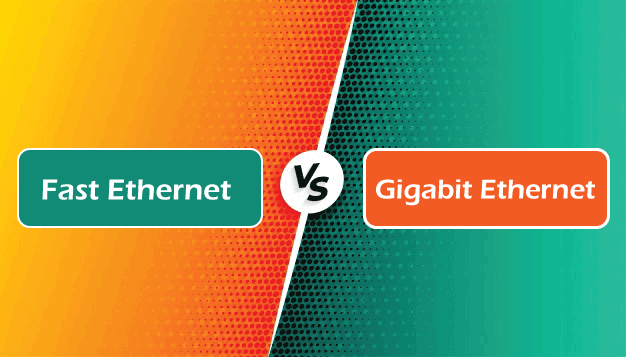Difference between Fast Ethernet and Gigabit EthernetToday, Ethernet connects computers in Local Area Networks (LAN), Wide Area Networks (WAN), and Metropolitan Area Networks (MAN). The IEEE 802.3u standard covers this technology, which was established in the 1990s. Ethernet is regarded as the most affordable network connectivity solution since it allows organizations to grow their network without disrupting their existing process. This technology is typically used to connect devices within a building and is not suitable for networks that span multiple nations. It enables all computer systems in a network to interact with one another over a single connection. Ethernet is classified into numerous types, which are distinguished mainly by its speeds. Fast Ethernet and Gigabit Ethernet are the most common and are still in use. In this article, you will learn about the difference between Fast Ethernet and Gigabit Ethernet. But before discussing the differences, you must know about Fast Ethernet and Gigabit Ethernet with their advantages and disadvantages. What is Fast Ethernet?Fast Ethernet was designed to compete with the LAN standard FDDI, and sometime it's known as 802u. It is based on 10-Base-T Ethernet. It was popular as it was simple to use, handle, maintain, and manage. It has the advantage of backward compatibility. It is ten times quicker than its previous version and may offer internet speeds of up to 100 Mbps. Fast Ethernet comes in three flavors: 100Base-T4, 100Base-Tx, and 100Base-Fx. The fast Ethernet MAC layer's data rate and collision domain differ from those of standard Ethernet. The data rate is increased by a factor of 10, but the collision rate is reduced by a factor of ten. Even if the frame format remains unchanged, how did it accomplish 10 times faster performance without changing the frame format? The RTT (round trip time) was reduced from 57.6 to 5.76 microseconds to accomplish this. The time required for a signal pulse or packet to go from one location to another and return is called round-trip time or round-trip delay. Advantages and Disadvantages of Fast EthernetThere are various advantages and disadvantages of Fast Ethernet. Some main advantages and disadvantages of Fast Ethernet are as follows: Advantages
Disadvantages
What is Gigabit Ethernet?Gigabit Ethernet was created to provide greater transmission rates of up to 1 Gbps and covers a distance of up to 70 kilometres. The initial goal was to create a system that could be used with existing networking hardware. It is based on Ethernet protocols like CSMA/CD and supports both full duplex and half duplex modes, like fast Ethernet. The IEEE 802.3ab standard established the applicability of Gigabit Ethernet for 1000 Base T networks while also permitting the use of existing UTP cabling. The IEEE 802.3ab standard validated Gigabit Ethernet usability for both desktop and industrial users using existing Category 5 cables. Additional 1000 Base T network protocols, especially 1000 Base LX10 and 1000 Base BX10 for multi-mode fibre and fibre optic transmissions, are certified by standard IEEE 802.3ah. Gigabit Ethernet network devices may send and receive data packets faster than other Ethernets. A Gigabit Ethernet switch may send data items or packets approximately 100 times faster than other Ethernet switches. It may fulfill increasingly complex network needs, like broadband internet connections for video streaming and connecting several bandwidth-intensive systems. The apps contain gigabit switches for controlling data transmission between many IP security cameras and network devices. Gigabit switches may support video and high-quality signal transfers between home servers and high-definition displays. Advantages and Disadvantages of Gigabit EthernetThere are various advantages and disadvantages of Gigabit Ethernet. Some main advantages and disadvantages of Gigabit Ethernet are as follows: Advantages
Disadvantages
Key Differences between Fast Ethernet and Gigabit Ethernet
There are various key differences between Fast Ethernet and Gigabit Ethernet. Some main differences between Fast Ethernet and Gigabit Ethernet are as follows:
Head-to-head comparison between Fast Ethernet and Fast EthernetHere, you will learn the head-to-head comparisons between Fast Ethernet and Gigabit Ethernet. The main differences between Fast Ethernet and Gigabit Ethernet are as follows:
ConclusionFast Ethernet and Gigabit Ethernet are the two varieties of Ethernet, with fast Ethernet being slower than Gigabit and offering maximum transmission speeds of up to 100 Mbps. In contrast, Gigabit Ethernet has boosted its maximum speed to 1 Gbps by enhancing the MAC layer, quality of service, flow control protocols, and cabling technology.
Next TopicDifference between
|
 For Videos Join Our Youtube Channel: Join Now
For Videos Join Our Youtube Channel: Join Now
Feedback
- Send your Feedback to [email protected]
Help Others, Please Share










